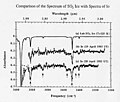Absorption spectroscopy
Absorption spectroscopy

Absorption spectroscopy is a technique used in analytical chemistry to determine the presence and concentration of a substance in a sample by measuring the amount of light absorbed by the sample. This method is based on the principle that atoms and molecules absorb light at specific wavelengths, which correspond to the energy differences between their electronic states.
Principles of Absorption Spectroscopy[edit]
Absorption spectroscopy involves the interaction of light with matter. When light passes through a sample, certain wavelengths are absorbed by the sample's atoms or molecules. The amount of light absorbed at each wavelength is measured and used to create an absorption spectrum. This spectrum can be used to identify the substance and determine its concentration.
The basic components of an absorption spectrometer include a light source, a sample holder, a monochromator to select specific wavelengths of light, and a detector to measure the intensity of transmitted light.
Types of Absorption Spectroscopy[edit]
There are several types of absorption spectroscopy, each suited to different applications:
- UV-Vis spectroscopy: Measures absorption in the ultraviolet and visible regions of the electromagnetic spectrum. It is commonly used for quantitative analysis of solutions.
- IR spectroscopy: Measures absorption in the infrared region, providing information about molecular vibrations and structure.
- Atomic absorption spectroscopy (AAS): Used to analyze metal ions in solutions by measuring the absorption of light by free atoms.
Applications[edit]
Absorption spectroscopy is widely used in various fields, including:
- Environmental science: Monitoring pollutants in air and water.
- Pharmaceutical industry: Quality control and drug development.
- Astronomy: Identifying elements in stars and planets.

Astronomical Applications[edit]
In astronomy, absorption spectroscopy is used to study the composition of stars, planets, and other celestial bodies. By analyzing the absorption lines in the spectra of stars, astronomers can determine the elements present in their atmospheres.

Spectral Lines[edit]
Absorption lines, such as the Fraunhofer lines in the solar spectrum, are dark lines that appear in the spectrum when light is absorbed by atoms or molecules. These lines are characteristic of specific elements and can be used to identify them.
Gallery[edit]
-
Emission spectrum of iron, showing lines that correspond to absorption lines.
-
Identification of ices in the solar system using absorption spectroscopy.
-
Cumulative absorption spectrum from the Hubble Space Telescope.
Related Pages[edit]
Absorption_spectroscopy[edit]
-
Overview of spectroscopy techniques
-
Sodium in the atmosphere of exoplanet HD 209458
-
Fraunhofer lines in the solar spectrum
-
Emission spectrum of iron (Fe)
-
Identification of ices in the Solar System
-
Cumulative absorption spectrum from the Hubble Telescope
Ad. Transform your life with W8MD's Budget GLP-1 injections from $75


W8MD offers a medical weight loss program to lose weight in Philadelphia. Our physician-supervised medical weight loss provides:
- Weight loss injections in NYC (generic and brand names):
- Zepbound / Mounjaro, Wegovy / Ozempic, Saxenda
- Most insurances accepted or discounted self-pay rates. We will obtain insurance prior authorizations if needed.
- Generic GLP1 weight loss injections from $75 for the starting dose.
- Also offer prescription weight loss medications including Phentermine, Qsymia, Diethylpropion, Contrave etc.
NYC weight loss doctor appointmentsNYC weight loss doctor appointments
Start your NYC weight loss journey today at our NYC medical weight loss and Philadelphia medical weight loss clinics.
- Call 718-946-5500 to lose weight in NYC or for medical weight loss in Philadelphia 215-676-2334.
- Tags:NYC medical weight loss, Philadelphia lose weight Zepbound NYC, Budget GLP1 weight loss injections, Wegovy Philadelphia, Wegovy NYC, Philadelphia medical weight loss, Brookly weight loss and Wegovy NYC
|
WikiMD's Wellness Encyclopedia |
| Let Food Be Thy Medicine Medicine Thy Food - Hippocrates |
Medical Disclaimer: WikiMD is not a substitute for professional medical advice. The information on WikiMD is provided as an information resource only, may be incorrect, outdated or misleading, and is not to be used or relied on for any diagnostic or treatment purposes. Please consult your health care provider before making any healthcare decisions or for guidance about a specific medical condition. WikiMD expressly disclaims responsibility, and shall have no liability, for any damages, loss, injury, or liability whatsoever suffered as a result of your reliance on the information contained in this site. By visiting this site you agree to the foregoing terms and conditions, which may from time to time be changed or supplemented by WikiMD. If you do not agree to the foregoing terms and conditions, you should not enter or use this site. See full disclaimer.
Credits:Most images are courtesy of Wikimedia commons, and templates, categories Wikipedia, licensed under CC BY SA or similar.
Translate this page: - East Asian
中文,
日本,
한국어,
South Asian
हिन्दी,
தமிழ்,
తెలుగు,
Urdu,
ಕನ್ನಡ,
Southeast Asian
Indonesian,
Vietnamese,
Thai,
မြန်မာဘာသာ,
বাংলা
European
español,
Deutsch,
français,
Greek,
português do Brasil,
polski,
română,
русский,
Nederlands,
norsk,
svenska,
suomi,
Italian
Middle Eastern & African
عربى,
Turkish,
Persian,
Hebrew,
Afrikaans,
isiZulu,
Kiswahili,
Other
Bulgarian,
Hungarian,
Czech,
Swedish,
മലയാളം,
मराठी,
ਪੰਜਾਬੀ,
ગુજરાતી,
Portuguese,
Ukrainian

